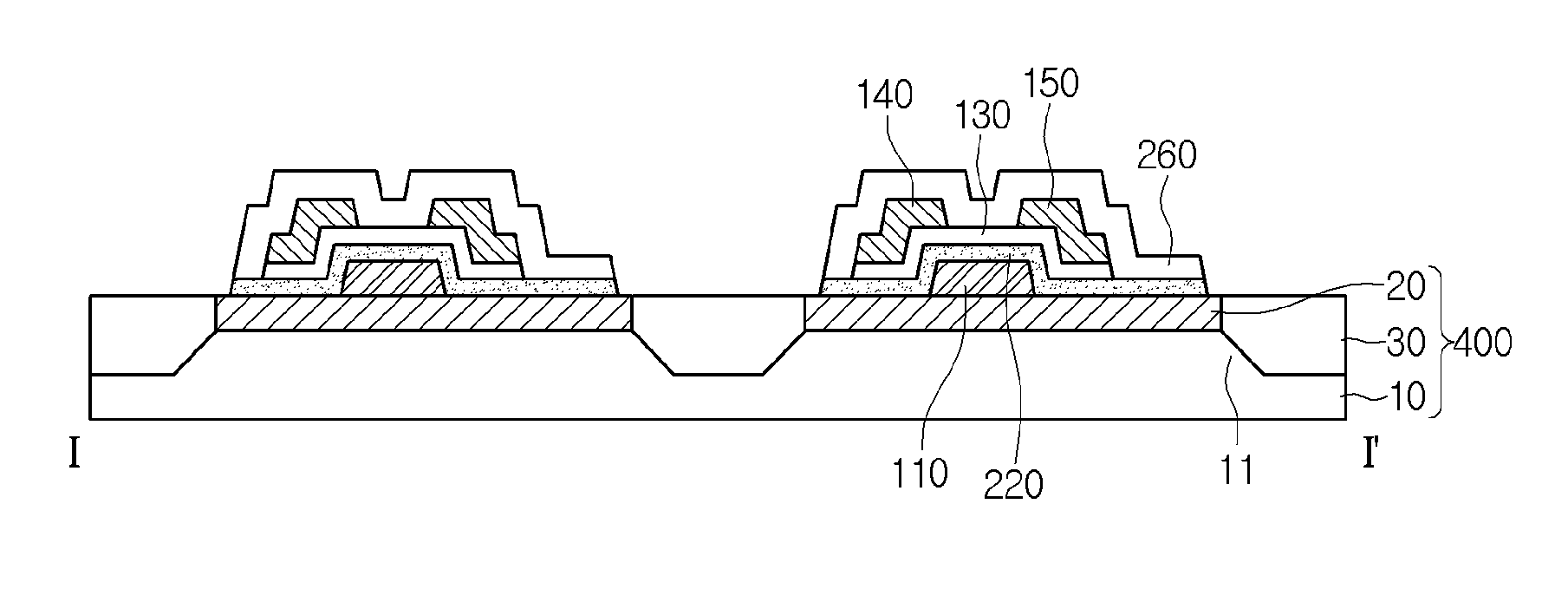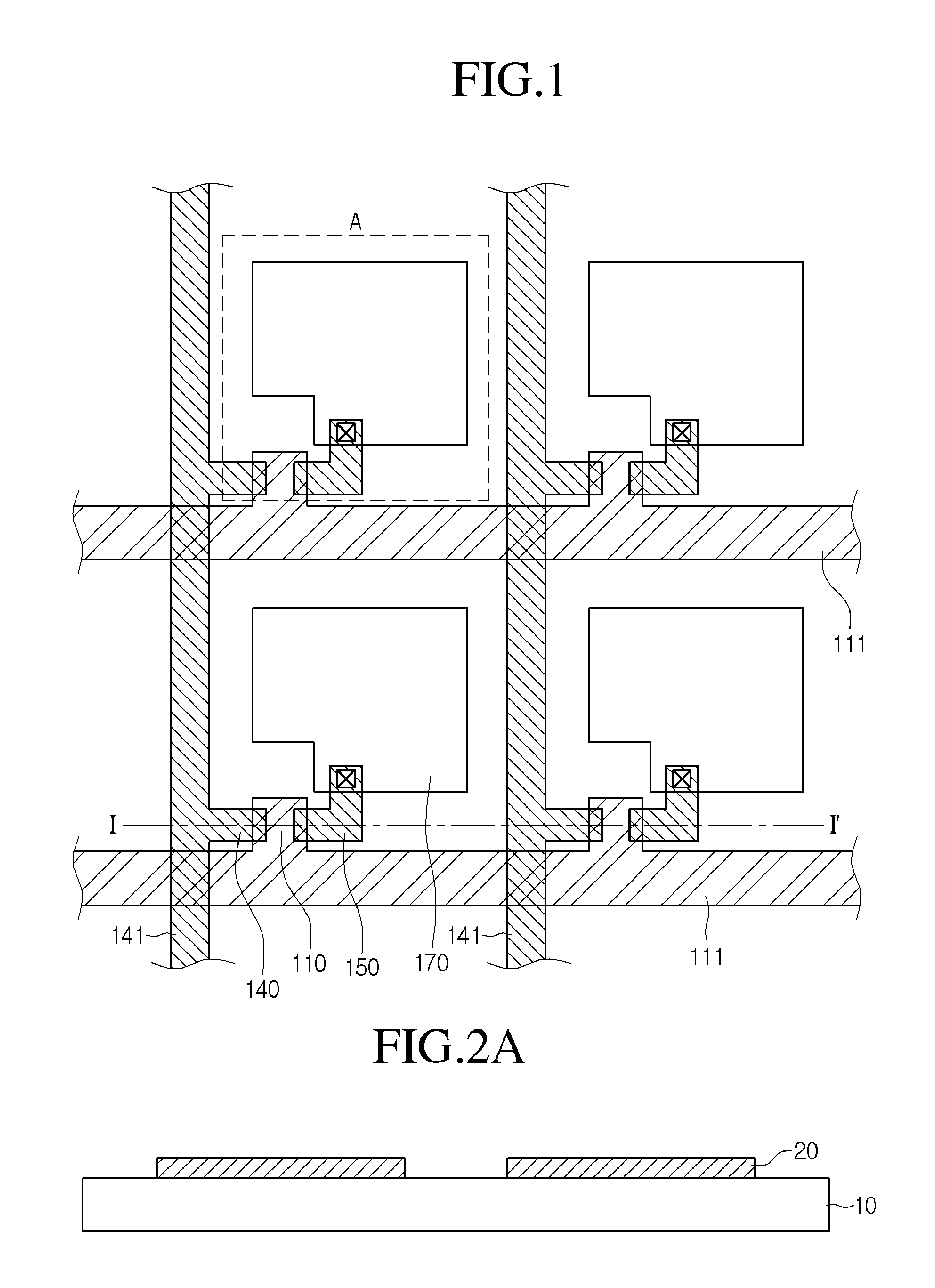Flexible display device and manufacturing method thereof
a flexible display and manufacturing method technology, applied in semiconductor devices, identification means, instruments, etc., can solve problems such as difficult diversification of design, thin film layer cracking or deterioration, display defects when bent or curved, etc., to improve flexibility and flexibility of flexible substrates, prevent the property deterioration of elements, and form stably elements
- Summary
- Abstract
- Description
- Claims
- Application Information
AI Technical Summary
Benefits of technology
Problems solved by technology
Method used
Image
Examples
second embodiment
[0030]FIGS. 2A through 2D are cross-sectional views illustrating a method of manufacturing a flexible display device of the present disclosure.
[0031]Referring to FIG. 2A, a barrier layer pattern 20 may be formed on a lower substrate 10. As an example of the lower substrate 10, a plastic thin film, a metal thin film, or others can be used. However, the lower substrate 10 is not limited to theses. In other words, the lower substrate 10 can be formed from any one of flexible materials different from the above-mentioned materials but suitable for the application.
[0032]The barrier layer pattern 20 can be formed from an inorganic material. Actually, the barrier layer pattern 20 can be formed from any one selected from a material group which includes SiO2, SiNx, SiNO, Ge, and mixtures thereof, but it is not limited to these. The barrier layer pattern 20 can be formed from an opaque inorganic material. In this case, the barrier layer pattern 20 can shield light incident to the thin film tr...
third embodiment
[0047]FIG. 3B is a perspective view showing a second example of the flexible substrate 300 according to the present disclosure. The flexible substrate 300 of the second example includes a barrier layer pattern 20 formed in an island shape and a prominence pattern 11 formed in an island shape. The barrier layer pattern 20 and the prominence pattern 11 which have the island shape can be formed in a region corresponding to a pixel region. In other words, the island pattern can be formed in a region corresponding to a pixel region. As such, the barrier layer pattern 20 and prominence patter 11 can be formed into the same number as the pixel regions. The barrier layer pattern 20 and the prominence pattern 11 each having the island shape can be formed only in a part of the pixel region which is occupied by a thin film transistor. Electronic elements will be formed on the flexible substrate 100.
first embodiment
[0048]FIG. 4 is a cross-sectional view along I-I′ from FIG. 1 showing a flexible display device according to the present disclosure.
[0049]As shown in FIG. 4, a gate electrode 110 branched from the gate line is formed on the flexible substrate 400. Also, a gate insulation film 120 can be formed on the entire surface of the flexible substrate 400 provided with the gate electrode 110.
[0050]The gate line and the gate electrode 110 can be formed by stacking at least one metals and transparent conductive materials in at least one layer. The metals include molybdenum Mo, titanium Ti, tantalum Ta, tungsten W, copper Cu, chrome Cr, aluminum Al, and alloys thereof. The transparent conductive materials include ITO (indium-tin-oxide), IZO (indium-zinc-oxide), and ITZO (indium-tin-zinc-oxide). Although the gate electrode 110 is formed in a single metal layer as shown in the drawing, it is not limited to this. In other words, the gate electrode 110 can be formed by stacking at least two metal lay...
PUM
 Login to View More
Login to View More Abstract
Description
Claims
Application Information
 Login to View More
Login to View More - R&D
- Intellectual Property
- Life Sciences
- Materials
- Tech Scout
- Unparalleled Data Quality
- Higher Quality Content
- 60% Fewer Hallucinations
Browse by: Latest US Patents, China's latest patents, Technical Efficacy Thesaurus, Application Domain, Technology Topic, Popular Technical Reports.
© 2025 PatSnap. All rights reserved.Legal|Privacy policy|Modern Slavery Act Transparency Statement|Sitemap|About US| Contact US: help@patsnap.com



